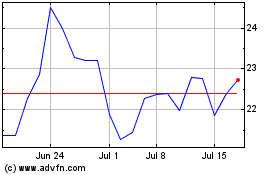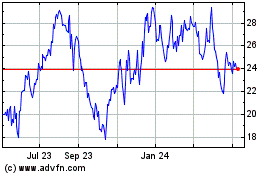By Suzanne Kapner and Jeffrey Sparshott
U.S. retail sales barely budged in July according to data
released Friday, capping a week of tepid earnings results from
department stores and underlining a seismic shift in consumer
spending.
Americans are still splashing out, but they are splurging less
on goods such as apparel and electronics and more on entertainment,
travel and health care.
Demand for clothing and household items in recent years has been
markedly softer than during past economic recoveries. And what
demand there is has been shifting online away from traditional
retailers such as Macy's Inc., Kohl's Corp. and Nordstrom Inc.,
which each reported lower quarterly sales this week.
Retail now represents only a slice of household outlays, with
consumption of services making up about two-thirds of all personal
expenditures. The monthly figures are closely watched as a gauge of
consumer sentiment and broader U.S. economic health.
A fuller picture of consumer demand will emerge next week when
some of the country's largest chains, including Wal-Mart Stores
Inc. and Home Depot Inc., report their latest results. Investors
expect slight sales gains at Wal-Mart, and stronger growth from the
big-box home improvement chain.
How those results pan out will have implications for the wider
economy. Consumers have been the main engine of tepid economic
growth this year as steady job gains, rising wages and lower energy
prices spur purchases.
According to the Commerce Department, sales at general
merchandise retailers, department stores and electronics chains all
fell in July, helping to depress overall retail sales, which were
unchanged at a seasonally adjusted $457.73 billion last month.
That is despite a 1.1% rise in auto sales, and a 1.3% gain from
non-store retailers, a category that includes online sellers like
Amazon and catalogs.
While July's headline retail sales figure was soft, "we view the
report as signaling a pause in a good pace of spending rather than
a sign of retreat by households," said Michael Moran, chief
economist at financial services firm Daiwa Capital Markets
America.
Oxford Economics, a global forecasting firm, expects a 2.6% gain
in gross domestic product this quarter over a year earlier. U.S.
households have increased spending every quarter since the end of
2009.
Since 2000, there has been a significant rotation in U.S.
spending away from goods and toward services. Craig Johnson,
president of retail consulting firm Customer Growth Partners,
estimates the shift represents about 5% of all consumer spending,
or about $600 billion annually.
By his count, the lion's share is going toward non-discretionary
items such as health care, housing, student debt and
transportation. "Those are things that people have little control
over, but have to come out of somewhere," Mr. Johnson said.
Health care accounts for about 20% of total consumption today,
up from 5% in 1960, according to IHS Global Insight economist Chris
Christopher. He expects the figure to rise to 25% of consumption by
2025.
When it comes to discretionary spending, consumers are opening
their wallets for travel and leisure activities. According to First
Data Corp., which tracks sales at four million merchant locations
across the country, travel expenditures rose 8.6% last month over a
year earlier.
"Overall leisure demand is very strong, but business travel
demand is slackening," said Douglas Quinby, vice president at
Phocuswright, a research firm. He said that shift is driving strong
passenger volumes for U.S. airlines and demand for vacation
rentals, but weak or declining revenue for carriers.
More worrisome are broader consumer spending drops at
sporting-goods stores, food and beverage stores, restaurants and
bars in July.
McDonald's Corp., Starbucks Corp. and other food chains reported
a pullback in customer visits in the latest quarter as the cost of
groceries is down sharper relative to the cost of eating out.
"There is tightening in disposable income, especially on the low
end," said Wendy's Co. CEO Todd Penegor said.
Lower sales aren't always a reflection of a weaker economy.
Retail numbers were dragged down by cheaper gasoline prices and the
July pullback may be just a blip. Monthly figures can be volatile;
last month's flatline follows a strong June and gauges of
confidence show consumers remain fairly upbeat.
But broader conflicting economic trends could leave Federal
Reserve officials with an uncertain view of the economy's
longer-term trajectory.
The labor market has been adding jobs and wages are rising,
boosting household balance sheets. But higher wages haven't spurred
inflation pressures, leaving room for continued central-bank
support. Overall economic growth has been muted, with gross
domestic product advancing at a meager 1% rate in the first half of
the year.
Business investment has been one of the biggest drags on the
economy as companies, squeezed by narrowing profits, have curtailed
spending on equipment and structures.
These economic crosscurrents have left the Federal Reserve
standing still. The Fed raised rates in December for the first time
since 2006 but many economists and investors doubt they will repeat
that move before December due to the uncertain performance by
businesses and consumers.
The stiff competition for consumer dollars is prompting some
retailers to shrink, moves that have been cheered by investors
worried by overcapacity. Macy's, which closed 41 stores earlier
this year, said on Thursday it would close another 100 locations by
early next year. That would reduce its footprint from last year's
prime shopping season by 18%.
It is an acknowledgment that some of the stores are worth more
as real estate, given that the "redevelopment opportunity exceeds
their value to us as a retail store," the chain's chief financial
officer, Karen Hoguet, said.
--Drew FitzGerald contributed to this article.
Write to Suzanne Kapner at Suzanne.Kapner@wsj.com and Jeffrey
Sparshott at jeffrey.sparshott@wsj.com
(END) Dow Jones Newswires
August 12, 2016 18:59 ET (22:59 GMT)
Copyright (c) 2016 Dow Jones & Company, Inc.
Kohls (NYSE:KSS)
Historical Stock Chart
From Mar 2024 to Apr 2024

Kohls (NYSE:KSS)
Historical Stock Chart
From Apr 2023 to Apr 2024
